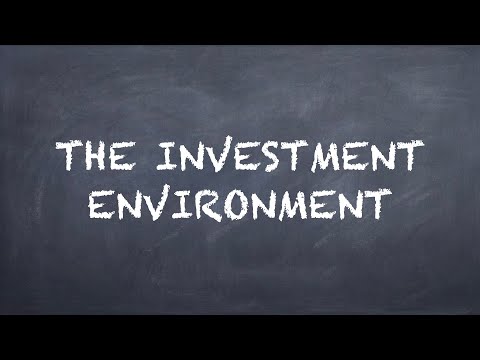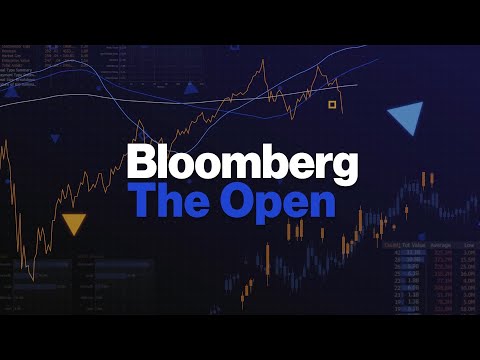The Investment Environment【Deric Business Class】

Hey. Guys welcome. To derek business class in this, video I'm gonna, explain to you the. Investment, environment. If. You have money in a savings account you're. Already an investor, because. You have at least one investment, to your name an, investment. Is any asset, into, which funds can be placed with the expectation. To generate, positive income, and to, preserve or increase its value, return. Is the reward for owning an investment, it, comes in two basic forms. First. Current. Income for. Examples, interest. Or dividend money. Invested, in a savings account provides. Income, in the form of periodic, interest payments, an ordinary. Share also provides, current income in the form of dividend, second. Capital, gain, investors. Often, buy shares because they expect, their price to rise so. That buying. Common, stocks offer both current income and the, chance of an increased, value which. Is what we call capital. Gain. Let's, look at the types of investments, first. Securities. Are property, investments. A security. Is a certificate, or other, financial instrument. That has monetary, value, and can, be traded. Securities. Are generally, classified as debt securities, such, as bonds, and debentures, equity. Securities. Such, as stocks and, derivative. Securities such. As options and futures, the. Sale of securities to, investors is, one of the primary ways that public. Companies receive. New capital, for operations. Property. Consists, of investments. In real property or tangible. Personal property. Real. Property, refers to land, buildings. And that which is permanently, affixed to the land, tangible. Personal property, includes. Items such as gold artwork. Antiques. And other, collectibles. Second. Direct. Or indirect, investments. A direct. Investment, means an investor. Directly, acquires a claim on a security, or property, if you. Buy common, stocks in a company, such, as Apple incorporated then. You have made a direct investment, and you, are a part owner of that company however. An indirect. Investment. Means and investor. Owns an interest, in a professionally. Managed collection, of securities, or properties, for. Example when. You purchase a mutual, fund or unit. Trust you, are making indirect, investments. In the assets held by these managed, funds. Next, debt, equity, or, derivative. Securities investment. Debt. Is an investment, in which the investor, lends funds in exchange. For periodic, interest, income and repayment. A full amount of loan and future date when. Companies, or governments, need to borrow money they, will issue bonds, when. You buy a bond basically. Means you lend money to the issuer the. Issuer will pay you periodic, interest for a specified, time at the, end of maturity, the, issuer will repay the original, loan amount to, you equity. Represents. Ongoing, ownership, in a business, or property an equity. Investment, may be held as a security, or, by title to a specific, property the. Most common, type of equity, security, is the common stock, derivative. Securities are, neither dead nor equity. Instead. They, derive their value from an underlying security. Or asset, for. Example, stock. Options, a stock. Option gives an investor, the right but, not the obligation to, buy, or sell a stock at an, agreed upon price and date the. Value, of this option depends, on the market price of the underlying shares. Next. Low, risk or high risk investments. Risk. Is the chance that actual. Investment, returns will differ from those expected. Simply. Speaking risk, is the uncertainty of receiving, return the. Broader the range of possible, returns, for an investment, the, greater the risk. Investments. Also differ on the basis, of risk risk. Reflects, the uncertainty, surrounding the, return that a particular, investment will generate, the. Broader the range of possible, values or returns associated. With an investment, the, greater is its risk for. Example, common. Stocks are generally, considered, more risky than bonds, because, the range of the highest, and the lowest returns. Of stocks is wider so. Low-risk. Investments. Provide a relatively, predictable but. Also a relatively, low return.
High-risk. Investments. Provide much higher returns, but, they also have the potential for much larger losses, that's. Why we say high. Risk high, turn low, risk low return. Next. Short-term. Or long-term investments. Which, is the life of an investment, short. Term investments. Typically, mature within one year such, as money market, investments. Long, term investments. Are those with longer maturities, are like, common, stocks with, no maturity at, all, the, last one, domestic. Or foreign investments. Most. Investments. Are domestic, investments. That. Will be the debt equity, and, derivative. Securities of. Local based companies, and governments, however. Investors. Also look for foreign investments. Both direct, and indirect, investments. That might offer more attractive, returns and purely domestic, investments. Next. Part let's, look at the investment, process, here. We, have suppliers, of funds and demanders, of funds, suppliers. Are those who have extra money whilst. Demanders. Are those who need money when. You have extra, money the, first way you can, consider putting money into financial, institutions. Such, as banks. Suppliers. Of funds put money in the financial, institutions. As deposits, then. Financial. Institution. Provides, money to the demanders, of funds as loans for. Such borrowing, demanders. Of funds will pay back interest to the financial, institutions. And financial. Institutions. Will pay interest to the suppliers, of funds that's. Why when, you save money in the banks deposit account you, will receive interest. That's. From the demanders, of funds the. Second way if you, don't want to deposit your money in the bank you may consider investing. Your money in the financial markets. Such, as share market, or bond market. Suppliers. Of funds provides, money to the financial, markets through. Buying a shares or bonds, then, the. Financial, markets, will transfer, the money to the demanders, of funds for. Receiving, the money the, demanders, of funds will provide securities. To the financial, markets, securities. Mean a certificate. Of shares or bonds, and then. Financial. Markets will transfer, the securities, to the suppliers, of funds that's. How we buy shares and bonds in the financial, markets, the, third way when, suppliers, of funds go directly to the demanders, of funds, that's when private placement, occurs for.
Receiving, Money from the suppliers, of funds the, demanders, will issue securities. To the suppliers, the. Flow of funds may also happen, between financial, institutions. And financial markets. It. Happens, when banks buy shares or bonds from the financial, markets. Let's. Take a closer look on suppliers, and demanders of, funds, government's. Businesses. And individuals. Are the key participants. In the investment, process each. May act as a supplier, or demander. Of funds first. Government. All, levels, of government, including. Federal, and state governments, need. Huge sums of money to finance long-term, projects. Related, to the construction, of public facilities and to, keep the government running. Typically. Government. Is a net demander, of funds which means it demands more funds than it supplies, because, government, spending, often exceeds tax revenues. Second. Businesses. Most. Companies require large. Sums of money to support their operations, especially. For the production, of goods and services, to. Finance both long term and, short term financial. Needs businesses. Issue a wide variety of debt and equity securities. Like. Government companies. Typically, are net demanders, of funds although they also supply, funds when they have excess cash, third. Individuals. Individuals. Demand, funds in the form of loans to pay for property, such, as for houses and cars and education. However. Overall. Individuals. Are net suppliers, of funds through. Their savings, individuals. Put more into the financial, system and they take out. There are two types of investors, in the investment, environment, first. Individual. Investors. Individual. Investors, manage, their own money and invest, for their personal, financial, goals such. As for retirement and buying houses. Second. Institutional. Investors. Institutional. Investors, your investment, professionals. Who, are paid to manage other people's, money they. Trade large volumes, of securities, for individuals, businesses, and, governments. Institutional. Investors, include, financial, institutions.
Such, As banks life. Insurance, companies, mutual. Funds and pension, funds, for. Example, a life, insurance company invests. The premiums, it receives, from policyholders. To, turn returns, that will cover death benefits, paid to beneficiaries. Investing. Can be carried out in a logical, progression of steps the. Following are the seven steps in investing, which, provide, useful guidelines, for, us step. 1, meeting. Investment, prerequisites. Before. Investing. You, must make sure that you, have adequately, provided, for the necessities, of life this. Includes, funds for housing food. Transportation. Taxes. And clothing, in. Addition, you, should have a pool of easily accessible. Funds for meeting emergency, cash needs, another. Prerequisite. Is adequate. Protection, against various, common, risk such. As death injury. Illnesses. Or disability. You. Can acquire the protection, through buying insurance such. As life. Insurance health. Insurance property. Insurance and, liability, insurance. Step. 2, establishing. Investment, goals once. You have satisfied the, prerequisites. The next, step is to establish investment. Goals. Investment. Goals are the financial, objectives, you wish to achieve by investing, then. Your, investment, goals will determine the types of investments, you will make common. Investment goals, include. Accumulating. Retirement. Funds. Accumulating. Funds for retirement is a single, most important, reason for investing. The. Earlier you start saving, money for retirement the. Greater the chance of accumulating, sufficient. Funds to meet your retirement, goals, second. Enhancing. Income. Investments. Enhance income, by earning dividend, or interest, it, is particularly, important. For retirees. As they, need high income at low risk for living third. Saving. For major expenditures. For. Those who have family, they, always put, aside money over the years to.
Accumulate, The funds needed for major expenditures. Such, as a down payment on a home travel. And capital. To start a business, fourth. Sheltering. Income from taxes, for. Buying certain types of investments. Such, as private, retirement scheme, PRS. Individuals. Are allowed to defer to avoid paying personal, income taxes. Step. 3, adopting. An investment, plan after. Establishing. Your investment, goals you, may develop an investment, plan. Investment. Plan is a written document that, describes how, you will invest your money for. Each goal specify. The target, date for achieving it and the, amount of tolerable, risk your. Investment, plan must be specific. And consistent. With your investment, goals step. 4, evaluating. Investment, vehicles, next. Step you, will have to evaluate the, investments. By assessing the potential return and risk of each investment, option, step. 5, selecting. Suitable investments. Now. You, may research, and gather information on specific, investments. That are consistent, with your investment, goals then. Make. Your investment, selections, based on some important, factors, such, as expected, return risk. And tax, considerations, a. Successful. Investing, depends, very much on the right selection, of investment, vehicles. Step, 6, constructing. A diversified, portfolio, to. Achieve your investment, goals you, will need to assemble an investment, portfolio of. Suitable, investments. Through. Diversification. Which, means combining a number of different investments. In a portfolio. You can earn higher returns, and reduce, risk that's. Why it's, important, to construct. And manage your own portfolios. Remember. Don't, put all your eggs in one basket in, the, market, many, individual, investors, buy mutual funds to achieve, diversification. And receive. The benefit, of professional, management, step. 7, managing. The portfolio. Once. You have constructed. Your portfolio, you should measure the actual performance in, relation to the expected, performance if the. Investment, results are not consistent. With your objectives you. May need to take corrective action.
Alright. The, above are the seven steps in investing. Before. Making your investing, decisions you. Will have to know the types of income for individuals first. Active. Income this. Is the income that you can earn from working, such, as wages, salaries. And pensions. Second. Portfolio. Income this. Is the income that you can earn from investments. Such, as interest, dividends. And capital gains. The. Third type passive. Income this. Is the income that you can earn from special, investments. Such, as rents, from real estate broils, ease and limited. Partnerships. Investors, tend to follow different investment. Philosophies. As they, move through different stages of the lifecycle. Generally. Speaking most, investors. Tend to be more aggressive when they're young and more, conservative, as they grow older, most. Young investors, in their. 20s, and 30s tend. To prefer growth oriented, investments. That, stress, capital, gains over current income because. Young investors, don't have much money to invest so. Capital. Gains are viewed as the quickest, way to build capital these. Investments. Have higher potential, growth at the same time higher. Potential, risk some. Examples, of investments. For youth stage include, common. Stocks options, or, futures. These. Are generally, growth oriented, and speculative. Investment, vehicles, as. Investors. Approach the middle-aged consolidation. Stage of life which. Age forty to sixty family. Demands and responsibilities. Become, more important, including. Educational. Expenses, and retirement. Savings the. Whole portfolio moves. Toward, less risky, investments, to preserve capital and a, transition, to higher quality securities. With lower risk some. Examples, of investments. For middle age stage include, low-risk. Growth and income stocks preferred. Stocks, convertible. Stocks, high-grade. Bonds, and mutual, funds. Finally, when, investors, approach their retirement, years which. Age 60, and above. Preservation. Of capital and current, income become, the primary goal they, need current income such. As interest or, dividend to, supplement, the retirement, income therefore. They. Prefer, highly conservative, investment, portfolio, that provides, a secure and high level of income is very important, to them capital. Gains are just merely a pleasant, occasional. Byproduct of, investing, some. Examples, of investments. For retirement stage, include. Low-risk. Income, stocks and mutual funds. Government. Bonds, quality. Corporate bonds, bank certificates. Of deposit, and other, short-term investments. Short-term. Investments, are an important, part of most savings and investment. Plans one. Of the reasons, is because they. Provide, liquidity, liquidity. Is, the ability of an investment, to, be converted, into cash quickly and with, little or no loss in value, so. Short-term. Investments. Are liquid, which, means they can be converted into cash quickly with, no loss in value the. Primary, use of short-term investments. Is for emergency, cash reserve, or, to save for a specific short-term. Financial, goal, financial. Planners always suggest, that you should, hold cash reserves, equivalent. To three to six months of your after-tax, salary, such. Emergency. Fund would be invested, in short-term investments. Which, is safe and liquid, the. Main advantages. Of short-term, investments. Are high, liquidity and, low, risk of default, risk. Of default means non-payment. The, reason, is that issuers. Of most short-term, investments. Are highly, reputable, institutions. Such, as the government, large. Banks, and major. Corporations. However. The, disadvantages. Of short-term investments. Are low, levels of return and loss, of potential purchasing. Power from inflation, because. Short-term investments. Have relatively, lower risk you, can expect the returns, are also lower the. Returns, even could be lower than the relation rate which, causes, the investors, to lose a purchasing, power over time, in, short, the money you earned from the short term investment. May, not be enough to cover the inflation. Individual. Investors, use short term investments. For both savings, and investment. As for. Savings purposes, their. Emphasis is on the safety, liquidity. And convenience. That's, why saving. Money in short term investments. Will be helpful when, they need emergency cash so. High-yield, is less important, for savings, purposes, as, for investment, purposes. Stable. Return, of short-term investments. Is important. Short-term. Investments. Are used as a component of a diversified, portfolio. Investors. Are advised to hold at least the part of their portfolio in, short, term and highly liquid securities.
Short. Term investments. Are also used, as temporary outlets. While waiting for attractive, long term investments. It, means when. There is no other investments. That are good for the investors, they, can temporarily put, their money in short term investments. Investments. Are sensitive, to the economic, conditions, of the market especially, common, stocks and other equity related securities, the. Business cycle refers. To the recurring, sequence, of growth and decline boom. An recession, that, characterizes. The economy, the. Business, cycle reflects. The current status of a number of economic, variables, such, as gross domestic product. GDP. Industrial. Production, personal. Disposable income the, unemployment, rate and so on there. Are three conditions of the economy, first. Recovery. Or expansion. A strong. Economy is reflected, in an expanding. Business, cycle, when. Business is good and profits, are up share. Prices tend to rise growth. Oriented, shares and speculative. Shares, tend to do especially well, in strong, markets. Second. Decline. Or recession share. Prices always fall on economic, activity, is declining, third. Change. In the general direction of the economy's, movement. That would be the turning points of the economy, from, good to bad or from, bad to good. Bonds. And other, forms, of fixed income securities. Such, as bond, funds and preference, shares are, also, sensitive to the business cycle because. They are highly sensitive to the movements, in interest, rates in fact. Interest. Rates are the single most important. Variable, in determining. Returns, to investors, for bonds and other fixed income securities. Interest. Rates and bond prices move, in opposite, directions, so. When, interest rates go up bond, prices, go down an. Opposite, when, interest rates go down bond. Prices, go up of course. When, bonds offer high returns, to attract investors, they, are also sold at a higher price. Alright that's, all for this video thanks for, watching see. You in the next one bye.
2020-06-13 01:01


